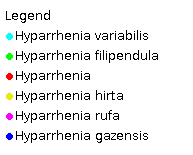Hyparrhenia Mex. Pl. 2: 51, 67 (1886).
Derivation:. From the Greek hypo (under) and arren (masculine), alluding to the male spikelets at the base of the racemes.
Taxonomic revisions, nomenclatural references:. W.D.Clayton, Kew Bull. Add. Series 2:1–196 (1969); B.K. Simon, Austrobaileya 3: 84–86 (1989).
Key references (keys and floras):. G.Bentham, Flora Australiensis 7:534 (1878) as Andropogon in part.; E.E.Henty, Manual Grasses New Guinea 110 (1969); J.W.Vickery, Flora of New South Wales, Gramineae 19: 55–57 (1961); M.Lazarides, Tropical Grasses S.E. Asia 47–49 (1980); J.C.Tothill and J.B.Hacker, Grasses of Southern Queensland 274–276 (1983); J.P.Jessop, Flora of South Australia 4: 1990 (1986); B.K.Simon, Key to Australian Grasses 125 (1993); S.W.L.Jacobs and C.A.Wall, Flora of New South Wales 4: 445–446 (1993); N.G.Walsh, Flora of Victoria 2: 625 (1994); D.Sharp and B.K.Simon, AusGrass (2002); J.P.Jessop, Grasses of South Australia 523 (2006); S.W.L.Jacobs, R.D.B.Whalley & D.J.B.Wheeler, Grasses of New South Wales, 4th ed, 281–283 (2008).
W.D.Clayton & S.A.Renvoize, Genera Graminum (1986), genus (612).
Native and naturalised. About 55 species, from the Mediterranean, Africa, Arabia and America. 3 species in Australia, WA, SA, Qld, and NSW. Also New Guinea and Malesia.
Habit. Annual (rarely) or perennial (usually large), tufted. Leaf blades narrow. Ligule an unfringed membrane.
Inflorescence. Inflorescence falsely paniculate (leafy, often with coloured spatheoles), a spatheathe panicle, spatheate, racemes paired or in clusters, not in tight heads, a compound pseudo-inflorescence. Spikelet-bearing axes racemes, with heteromorphic spikelets (imperfect spikelets sometimes with awned glumes, the upper lemma awnless), paired, disarticulating at joints. Internodes disarticulating obliquely, densely long-hairy or somewhat hairy or glabrous.
Spikelets. Spikelets subterete to dorsally compressed, 2 flowered, with 1 fertile floret, paired (with terminal triplets), in pedicelled/sessile combinations; sessile spikelet with lower incomplete floret. Fertile spikelets falling with glumes.
Glumes. Glumes more or less equal, long relative to adjacent lemmas, truncate, awnless, dissimilar (the lower dorsally rounded or flattened, the upper narrower, shallowly naviculate). Lower glume striate or grooved, convex on back (rarely slightly concave or with two or more shallow depressions), relatively smooth, 7–9 nerved. Upper glume 3 nerved.
Florets. Lower incomplete floret(s) sterile. Lemmas awnless, 0 nerved or 2 nerved, similar in texture to fertile lemmas (hyaline), not becoming indurated. Fertile florets 1. Lemmas hyaline below, stipitate to the awn, less firm than glumes (hyaline, but hardening into the awn), not becoming indurated, incised, awned, without a germination flap, 1 nerved, hairy or glabrous. Awns 1, from a sinus (flanked by tiny teeth), geniculate, hairy or long-plumose, much longer than body of lemma. Palea present or absent, when present relatively long or conspicuous and relatively short or very reduced, 2 nerved or nerveless. Callus pointed to blunt. Lodicules 2. Stamens 3. Grain compressed dorsiventrally or terete. Hilum short. Embryo large. Pedicels free of rachis. Pedicelled spikelets present, similar in shape to sessile spikelet, male, with glumes, 1 floreted or 2 floreted.
Kranz Anatomy. C4, biochemical type NADP-ME (H. hirta).
2n = 20, 30, 40, 44, 45, and 60, 2, 4, and 6 ploid, commonly adventive.
Habitat. Mesophytic, xerophytic. Savanna. Species of open habitats.
Classification. Panicoideae; Andropogoneae.
Notes. The genus is noteworthy for its elaborate compound panicles, an important element of which is the raceme-base. This may be adapted to deflex at maturity, or to supplement the spatheole by supporting an inner protective cover of long bristles or involucral homogamous spikelets (Clayton and Renvoize, 1986).
Types Species. H.foliosa (Kunth) Anderss. ex E.Fourn. = H. bracteata Humb. & Bonpl. ex Willd.) Stapf.
Biogeographic Element. Clifford & Simon 1981, Simon & Jacobs 1990: Old World Tropics.


